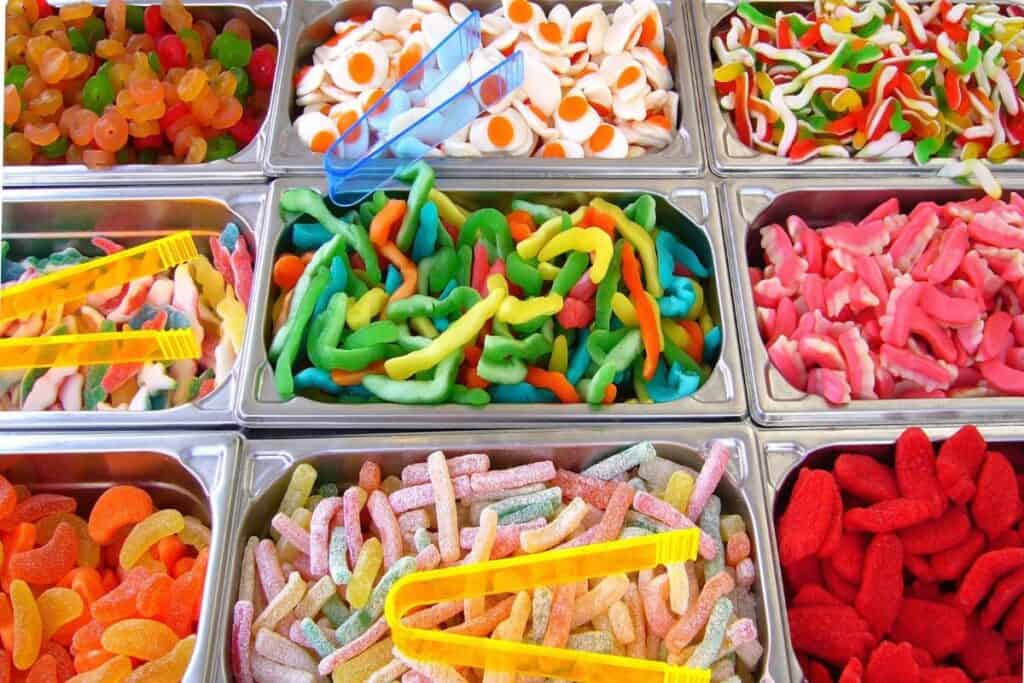We’re dietitians and parents – we know the struggle can be real when it comes to keeping our kids’ oral health in check, but it’s for good reason. Nutrition can and does impact oral hygiene which is a major part of overall health. Knowing what you can do as parents to keep their teeth healthy can help prevent oral disease and protect their teeth into adulthood. But first, let’s dive into what exactly a cavity is…
What is a Cavity And How Does it Form?
What is a cavity? Essentially it’s a hole in a tooth! You may have heard the phrase “sugar causes cavities” but that’s not entiiii-re-ly true. Let’s review.
Our mouths are home to colonies of bacteria, which feed on the carbohydrates we eat (sugar is a type of carbohydrate). Whenever the bacteria get fed, they produce acid. This acid, in turn, is what actually causes the tooth to decay.
Whenever you eat something, dentists call this an “acid attack” due to the bacteria breaking down the food into acid. Thankfully, we have a built-in defence against the acid – our saliva! Our saliva is basic, which works to neutralize the acid.
To take a deeper dive, bacteria can cling to the teeth easier when plaque forms on the teeth. Plaque is a thin, sticky layer of tiny food particles, bacteria, and saliva that forms over time.
Now that we know what a cavity is, how can we prevent one from forming?
To sum up the situation, for cavities to form, bacteria use:
- carbohydrates
- plaque
- time
So to prevent cavities from forming, you can look at intervening at any of those points. You can also look at strengthening the enamel (mineralized outer layer of the tooth) to create a stronger defence.

Strategy #1: Cutting Off the Food Source
If the bacteria don’t have any carbohydrates to break down, they can’t produce acid! It’s neither practical nor recommended to cut out carbohydrates for kids. They need that energy to grow, develop, think, and play! But by being strategic, you can make those carbohydrates less available for oral bacteria!
There are four different ways to do this:
Limit grazing in between meals and snacks
Having a flexible meal and snack schedule has a host of benefits that we appreciate as Registered Dietitians but we’re focusing on how it can actually support oral health, for the better! Did you know that it takes about 20 minutes for our saliva to neutralize the acid formed from eating something? The fewer “acid attacks” your teeth have to endure throughout the day, the better! If your child is consuming bits or pieces of sweet foods throughout the day then they become at risk of having repeat acid attacks which can result in tooth decay.
If a meal and snack schedule is new to you, start slow and tread with a lot of self-compassion. It can be tough to transition away from constant grazing but trust us, it’s going to be worth it. Don’t forget, a Dietitian can help!
Keep sweets to mealtimes
If a sweet or sticky food is on the menu, do your best to serve it alongside a meal. Doing so may reduce the intensity of the “acid attack” on their teeth. To add, from a psychological perspective serving sweet foods in a meal setting may make it easier for children to keep sweet foods neutral – in a way, the ice cream or cookie isn’t more than the roasted vegetables or enchiladas you’ve prepared. Basically, it keeps all foods at an even playing field!
Only water to drink in between meals and snacks
We can’t talk about oral health without talking about beverages. Formally, we recommend allowing your child unlimited access to water that they can sip on throughout the day. During meals feel free to serve milk, juice, or whatever other beverage your family enjoys. The reason we want to prevent constant sipping of milk and juice in between meals goes back to the earlier discussion point: prolonging the amount of time teeth are exposed to sugar which in turn may negatively impact dental hygiene.
Some parents may choose to dilute juice in an effort to reduce the amount of sugar consumed, but this may not make a clinically significant difference when it comes to reducing dental health risks. It’s really up to a parent if they want to dilute juice! Ultimately, we still recommend keeping juice to mealtimes whether it’s diluted or not.
If you’re curious about how to best fit juice into your child’s diet, we’ve partnered with the Canadian Sugar Institute for this article: How to Approach Juice with Your Toddler.

Minimize Sticky Sweets
Sticky foods are going to do just that: stick to your teeth! This makes it harder for our saliva to wash the food particles away from our teeth. We’re not saying that you should never allow your child to eat something sticky but these foods do carry a bit more risk for cavities.
While not exhaustive, here are some examples of sticky foods:
- Gummy candies
- Fruit snacks
- Fudge
- Dried fruit
- Fruit leather
- Taffy
- Chewing gum made with sugar
When possible, choose less sticky desserts. Let’s say you’re at the fair grounds – you could choose ice cream over a candy apple. Or let’s say you want to add something sweet into your child’s lunchbox. You could choose chocolate instead of fruit snacks.

Strategy #2: Preventing Plaque Build-Up
Remember – plaque is a thin, sticky layer of leftover miniscule food particles, bacteria, and saliva that forms on the surface of the teeth. When we reduce the amount of plaque formation, we reduce the risk of cavities!
Focus on Hydration
There are soooo many benefits for keeping up with the fluids! When it comes to oral health, saliva is a key fighter in preventing cavities. Our saliva is 98% water, so we need to make sure our bodies are fully hydrated so that they can produce enough saliva.
Drinking water also washes away food particles, rendering them unavailable for the bacteria to break down.
Establish a Good Teeth Brushing Routine
The physical action of brushing breaks up plaque that has formed on the teeth.
According to the Canadian Dental Association, the best defence is to brush teeth after every meal. If that’s not possible, then the most critical time of day is just before bed. This is because we produce less saliva while we’re sleeping.
For more personalised advice, connect with your dentist to ask how frequently they recommend brushing your child’s teeth.
Suggested Read: When to Start Brushing Your Baby’s Teeth [+ the 411 on baby’s oral hygiene]
Strategy #3: Strengthen The Enamel
There are a variety of ways to keep your teeth strong, but since we’re nutrition-focused Dietitians, we’re going to talk about…
Why Vitamin D Is Needed for Strong Teeth
Vitamin D is a key player when it comes to tooth mineralization. Check out the stats from some of the research in this area:
- A high dose of Vitamin D during pregnancy resulted in about 50% reduction in enamel defects in the child
- This pooled analysis of several studies showed a 47% reduction in cavity risk
Unfortunately, Vitamin D is not a nutrient most children can reliably get from food sources. If you’re not already supplementing with Vitamin D, chat with your doctor or a Registered Dietitian to determine what dose might benefit your child.
Suggested Read: Vitamin D for Babies

Is it Best to Completely Avoid Sweets And Sugar to Protect Teeth?
Some parents may feel inclined to restrict the intake of sweet foods with the intention of protecting their child’s teeth. But, truth be told, restricting the intake of food probably isn’t the sole solution to preventing tooth decay. There are other factors that might contribute to one’s risk of tooth decay outside of sugar intake such as teeth anatomy, weak enamel or even the oral microbiome.
Dental health is incredibly important and we definitely don’t want to dismiss that, but so is the enjoyment of a variety of foods (including sweets) and our child’s relationship with food. The last thing we want is for children to fear enjoying sweet foods! We’ve also learned that restriction often drives further preoccupation with the restricted food so this strategy could really backfire!
And with that, we hope you feel armed with more information about what a cavity is and the steps you can take to optimize your child’s oral health.






